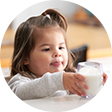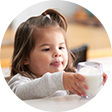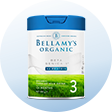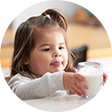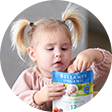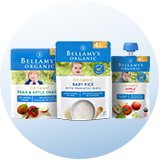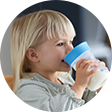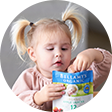High Energy Foods for Breastfeeding Mums
There are numerous benefits of breast feeding, in particular the many health benefits for your baby. However, many women struggle to find a diet that helps them produce enough milk and maintain their energy levels. Ideally a balanced diet includes healthy grains, fruit & vegetables, protein and dairy – though every mother’s dietary needs will vary.
What about the baby?
Even in countries where food is scarce, breastfed babies are able to thrive. Deficiencies in nutrients, such as iodine and vitamin B12, may affect breast milk, but the main focus of your diet now should be fulfilling your own nutritional needs. Your body will usually cope with the demands of breastfeeding by increasing your appetite, using nutrients more efficiently, drawing on the fat stores laid down in pregnancy, and reducing the amount of energy you use.
What about me?
For women on a typical Australian diet, the main nutrients you should focus on are iodine, calcium and iron. The National Health and Medical Research Council (NHMRC) recommends that breastfeeding women should take an iodine supplement of 150 micrograms (μg) each day. Breastfeeding mothers also need to keep up their calcium levels. When your body isn’t getting enough calcium from your diet it will draw on the supplies from your bones which can put you at risk of osteoporosis later in life. It is also important for you to build up your iron levels, which may have been depleted during pregnancy. One early sign that you may be low in iron is if you feel fit walking on flat ground but tire quickly on inclines.
What is the recommended diet for breastfeeding women?
Last year the NHMRC set out some healthy eating guidelines for breastfeeding women. One thing you’ll notice with a new baby is how much your lifestyle and appetite changes. Use these guidelines as a starting point, the main thing is to eat a variety of healthy foods and keep your water intake up.
Grains (9 serves per day)
Eat mostly whole grains and high-fibre cereals. One serve might be any one of these options:
- 1 slice (40 g) bread
- ½ (40 g) medium roll or flat bread
- ½ cup (75–120 g) cooked rice, pasta, noodles, barley, buckwheat, semolina, polenta, bulgur, quinoa
- ½ cup (120 g) cooked porridge
- 2/3 cup (30 g) wheat cereal flakes
- ¼ cup (30 g) muesli
- 3 (35 g) crispbreads
- 1 (60 g) crumpet
- 1 small (35 g) English muffin or scone
Vegetables and legumes (7.5 serves per day)
About 75 g from a variety of different coloured vegetables, for example:
- ½ cup cooked green or orange vegetables
- ½ cup cooked dried or canned beans, peas, lentils
- 1 cup green leafy or raw salad vegetables
- ½ cup sweet corn
- ½ medium potato or other starchy vegetable (sweet potato, taro, cassava)
- 1 medium tomato
Fruit (2 serves per day)
About 150g of a wide selection of fruits, for example:
- 1 medium apple, banana, orange, pear
- 2 small apricots, kiwi fruit, plums
- 1 cup dried or canned fruit
Occasionally:
- ½ cup (125 mL) fruit juice with no added sugar
- 30 g dried fruit (4 dried apricot halves, 1½ tbsp sultanas)
Dairy or alternatives (2.5 serves)
Mostly reduced fat products, such as:
- 1 cup (250 mL) fresh, UHT long-life, reconstituted powdered milk or buttermilk
- ½ cup (120 mL) evaporated milk
- 2 slices (40 g) or 4x3x2 cm cube (40 g) hard cheese
- ½ cup (120 g) ricotta cheese
- ¾ cup (200 g) yoghurt
- 1 cup (250 mL) soy, rice or other cereal drink with at least 100 mg/100 mL calcium
- 100 g almonds with skin
- 60 g sardines, canned in water
- ½ cup (100 g) canned pink salmon with bones
- 100 g firm tofu (check label for calcium content)
Protein (2.5 serves)
Lean meats and poultry, fish, eggs, tofu, nuts, seed, legumes/beans, for example:
- 65 g cooked lean red meat such as beef, lamb, veal, pork, goat or kangaroo (90–100 g raw)
- 80 g cooked lean poultry (100 g raw)
- 100 g cooked fish fillet (115 g raw)
- 1 small can fish
- 2 large (120 g) eggs
- 1 cup (150 g) cooked or canned legumes/beans such as lentils, chickpeas or split peas
- 170 g tofu
- 30 g nuts, seeds, or nut or seed paste
Additional serves for taller, active or underweight mothers (0 - 2.5 serves)
More from other food groups or unsaturated spreads and oils or discretionary foods
- 10 g poly/monounsaturated spread
- 7 g polyunsaturated oil such as olive, canola
- 10 g nuts or nut paste
This may sound like a lot of food, but you’ll be surprised at how much you end up eating while breastfeeding. And it’s important to remember that even though your baby is now with you in the world, you are still their main source of food. So you need to be eating the right nutrients to give them the best start at life.
Important Notice
Thanks for reading our blog. We hope you found this information interesting.
- The World Health Organisation recommends that breastfeeding is best for your baby.
- Having a balanced diet when breastfeeding is also important. Baby formulas should only be used after you’ve sought advice from a doctor or health practitioner.
- A decision not to breastfeed can be difficult to reverse and introducing partial bottle feeding will reduce the supply of breast milk. It is also wise to consider the cost of infant formula.
- If you use infant formula, all preparation and feeding instructions must be followed as per the manufacturer’s instructions. This is important for your baby’s health.

